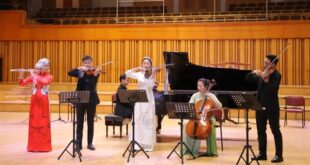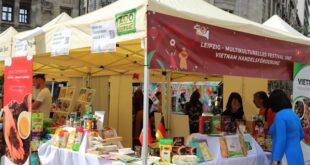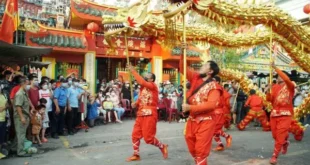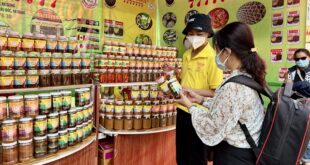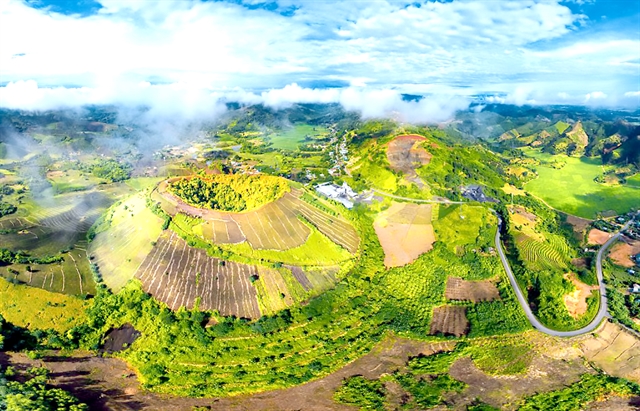 |
| Nam Ka Volcano in Đắk Nông Geopark. Photo krongno.daknong.gov.vn |
HÀ NỘI – Đắk Nông Geopark in the Central Highlands province of Đắk Nông has been validated as a member of UNESCO Global Geoparks Network for another four years, from 2024 to 2027.
The decision has been approved by the UNESCO Global Geopark Council within the framework of the 10th International Conference on UNESCO Global Geoparks held in Morocco last year.
The certification will be granted to the province at the 8th Asia Pacific Geoparks Network Symposium, scheduled to take place in September this year in the northern mountain province of Cao Bằng.
The revalidation reflects Đắk Nông’s efforts to protect and promote the values of the geopark and offers an opportunity to attract resources for the province’s sustainable socio-economic development.
The Đắk Nông Geopark was recognised by UNESCO as a global geopark in July 2020, becoming the third to obtain this title in Việt Nam, after Đồng Văn Karst Plateau Geopark in the northern mounain province of Hà Giang Province and the Non Nước Cao Bằng Geopark in Cao Bằng.
The geopark covers more than 4,700 sq.km, stretching through six districts and cities, Krông Nô, Cư Jút, Đắk Mil, Đắk Song, Đắk G’long and Gia Nghĩa, equivalent to two-fifths of the province’s total area.
It is home to 65 geological and geomorphological heritage sites, including a system of nearly 50 caves with a total length of more than 10,000 metres, craters and waterfalls.
 |
| Crater C7 within Đắk Nông Geopark. –Photo dantocmiennui.vn |
With a tropical forest ecosystem, the geopark holds immense biodiversity values. This land also preserves many unique cultural, geological and natural features as well as traces of prehistoric activities.
The history of this land goes back 140 million years ago, when it was part of the ocean with traces found such as sedimentary rocks, ammonite fossils and other fossils. The tectonic movement of the Earth’s crust caused this area to raise and volcanic appearance. Volcanic eruptions covered half of the area with layers of basalt lava.
As a part of the poetic and majestic M’Nông plateau, the geopark is the convergence of typical geological, archaeological and cultural and biodiversity values of the region.
The special feature in the Đắk Nông Geopark area is the cave system in basalt rock located in the Đray Sáp-Chư R’Luh area, which was discovered in 2007. This volcanic channel has been recorded as the longest one in Southeast Asia by the Japan Volcanic Cave Association in terms of scale, length and uniqueness. These caves still contain many secrets about formation mechanisms, mineral complexes, biodiversity and archaeological sites.
In the geopark’s area, there is also ancient geological heritage such as fossils of ammonites, natural lakes like Ea Snô, West Lake and a system of beautiful and majestic waterfalls like Gia Long, Trinh Nữ and Đray Sáp.
In addition, it also boasts a variety of bauxite, antimony, tin placer deposits, puzzolite and precious stone mines, especially opal – chalcedony semi-precious stones.
The archaeological findings of prehistoric people in the volcanic cave area of the geopark have attracted the attention of domestic and foreign researchers and visitors.
Initial research suggest that the area dates from the Late Stone Age and Early Metal Age dating back to 6,000-3,000 years ago. The findings included stone tools such as stoneware, dish-shaped tools and short axes. Animal bones, fragments and prehistoric human bones were also found.
Regarding ceramics, there are many types of items, with different thicknesses and thinness, made from sandy clay. The patterns on the ceramic pieces are quite sharp and diverse such as dots and dashes, and rope patterns.
The geopark is also home to tangible and intangible cultural values, in particular the UNESCO-recognised ‘Gong Culture Space’ intangible heritage and the Hồ Chí Minh Trail special national relic.
Visitors to the geopark can also experience the diverse spiritual life of local ethnic groups, reflected through folk beliefs, rituals and folk art which should be well preserved and promoted.
The flora and fauna system in the park is diverse with many rare species, listed in Việt Nam and the world’s red books such as elephants, tigers, bison and some types of primates, namely voọc đen má trắng (Trachypithecus francoisi), chà vá chân đen (Pygathrix nigripes), reptiles, chim Hồng Hoàng (Great Hornbill) and gà tiền mặt đỏ (Germain’s Peacock Pheasant). VNS
- Reduce Hair Loss with PURA D’OR Gold Label Shampoo
- Castor Oil Has Made a “Huge” Difference With Hair and Brow Growth
- Excessive hair loss in men: Signs of illness that cannot be subjective
- Dịch Vụ SEO Website ở Los Angeles, CA: đưa trang web doanh nghiệp bạn lên top Google
- Nails Salon Sierra Madre
 VnExpress News The News Gateway of Vietnam
VnExpress News The News Gateway of Vietnam
